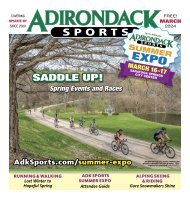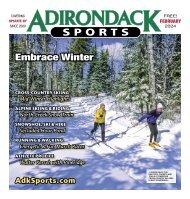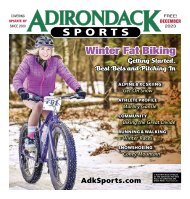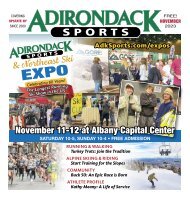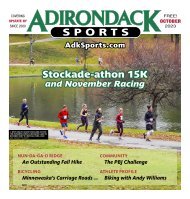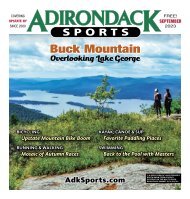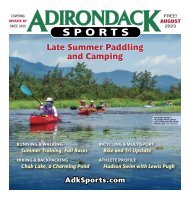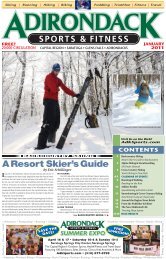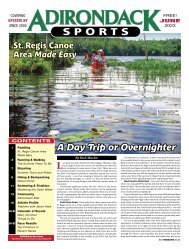Adirondack Sports May 2020
In This Issue: BICYCLING - Find Your Own Trail Ride PADDLING - Lessons I Have Learned From the Publisher & News Briefs RUNNING - Running Reinvention HIKING & PACKPACKING - Big Bad Luck ATHLETE PROFILE - Mountain Biking with Anna Laloë CALENDAR OF EVENTS - Canceled, Postponed, Virtual & Happening Events! GREAT WALKS & DAY HIKES - Close to Home: Swift Wetland and Van Dyke Preserve
In This Issue:
BICYCLING - Find Your Own Trail Ride
PADDLING - Lessons I Have Learned
From the Publisher & News Briefs
RUNNING - Running Reinvention
HIKING & PACKPACKING - Big Bad Luck
ATHLETE PROFILE - Mountain Biking with Anna Laloë
CALENDAR OF EVENTS - Canceled, Postponed, Virtual & Happening Events!
GREAT WALKS & DAY HIKES - Close to Home: Swift Wetland and Van Dyke Preserve
Create successful ePaper yourself
Turn your PDF publications into a flip-book with our unique Google optimized e-Paper software.
PADDLING<br />
MAY <strong>2020</strong> 3<br />
Lessons I Have Learned<br />
By Rich Macha<br />
There are numerous ways we can learn about a subject,<br />
but for many of us, there is nothing like first-hand<br />
experience to really drive a point home. However,<br />
some of those experiences are best avoided and we can learn<br />
by listening to the voice of experience whether it be in print,<br />
video or in person. There are a few paddling-oriented things<br />
that I do not think get enough attention and I will touch on<br />
some of them here.<br />
The weather – There are several ways we can get a weather<br />
forecast these days, and thanks to the internet, it’s possible<br />
to get a forecast for the exact location you are planning<br />
to paddle. Knowing that it will be warm and sunny is nice<br />
but it will be the strength and direction of the wind that will<br />
affect your paddling day the most. The wind, and resulting<br />
waves, will be a greater factor when paddling large lakes and<br />
less important when paddling small streams. I have changed<br />
plans from the former to the latter when I saw that moderate<br />
to high winds were in the forecast. The greater the fetch, the<br />
distance over which the wind travels unimpeded, the more<br />
you will feel its effects. When the forecast is predicting winds<br />
of 10-15mph, I usually anticipate it to be 10-20mph once I<br />
get out on open water, and I question whether that would be<br />
advisable to paddle.<br />
The direction of the wind is also very important. For<br />
example, if the lake is oriented in a south-north direction,<br />
and the wind is coming from the north or south, it will affect<br />
the conditions much more than if the wind was from the west<br />
or east. A number of years ago a small group of us kayaked<br />
out to Valcour Island on Lake Champlain, and camped on the<br />
island’s east side, only to find that the wind had turned to the<br />
south the next morning – and waves were in the three-foot<br />
range. None of us wanted to return to the Peru boat launch<br />
in those conditions, even though it was only two miles away.<br />
I also wondered if I had brought enough food to stay another<br />
day and wait for things to calm down. Luckily, by late afternoon,<br />
the wind direction changed to westerly and we were<br />
able to paddle out uneventfully.<br />
If you must paddle in the wind, you will have an easier<br />
time of it if you paddle along the same shore that the wind<br />
is coming from. For example, if the wind is coming from the<br />
west, then paddling along the west shore should be fine. I<br />
have often paddled a longer but safer distance by following<br />
the shoreline, plus I find that there is always more to see there<br />
anyway. Mornings are usually the best time of day to paddle<br />
when the lake surface is often calm, and special memories<br />
can be created while experiencing sunrises and morning<br />
mist. Kayakers have the advantage of choosing to use a spray<br />
skirt to keep water from entering the cockpit area, and there<br />
can be times where paddling in waves can actually be fun<br />
when so equipped.<br />
Decision making, aka the warm and sunny day syndrome<br />
– It’s a sunny spring day with the temperature in the<br />
70s so let’s go kayak the Schoharie Creek despite having limited<br />
skills – like being able to maneuver in a strong current<br />
– and despite the fact that the water level is sort of on the<br />
high side.<br />
Two people, in separate incidents a few hours apart,<br />
were rescued from the creek early this <strong>May</strong>. A fair amount<br />
of rain had fallen that week and the water level had risen to<br />
three feet on the gauge at Burtonsville. Through my research<br />
and experience, I have learned that a level of between 1.5-2<br />
feet is best for a fun trip on the Schoharie above and below<br />
Middleburgh. At three feet, the flow is three times more powerful<br />
than when the river is at two feet – 4,500 cubic feet per<br />
second versus 1,500cfs.<br />
My biggest fear when paddling moving water is coming<br />
up on strainers – trees that have fallen down across the water.<br />
Often, there is a way around them but there may only be a<br />
WIND WAVES ON<br />
LAKE CHAMPLAIN<br />
AT AUSABLE POINT.<br />
small opening and aggressive maneuvering is necessary. This<br />
was the case at the time of the incidents on a stretch of the<br />
Schoharie, across from the cliffs of Vroman’s Nose, and the<br />
kayakers were unable to paddle past successfully. Rescue<br />
personnel included fire and ambulance, swift-water rescue,<br />
search and rescue, police and homeland security – not good<br />
in these days of Covid-19.<br />
When exploring moving waters for the first time, I highly<br />
recommend that you go with someone who knows the river<br />
well, learn and practice some maneuvering strokes like draw<br />
strokes, and do some research before venturing out.<br />
Painters – A painter is just a rope that is attached to your<br />
canoe or kayak, most often to the bow, but it does not hurt to<br />
have one attached to the stern too. A painter can be used to<br />
line a boat through shallows, pull it over beaver dams, and to<br />
secure it on shore when you stop for a break or at a campsite<br />
so that it does not wander off when you are not watching.<br />
I was once camping on one of the islands on Lake George,<br />
and sat by the water enjoying my morning coffee, when I spotted<br />
an empty canoe floating between the islands. I jumped<br />
into my canoe, and towed it back to my island, where I tied it<br />
to a tree in a spot where it could easily be seen. Unfortunately,<br />
I did not get to see the faces of the owners when they discovered<br />
their transportation out of there was missing. Since<br />
then, I always tie down my boat even when I bring it in well<br />
away from shore – you never know when the wind could kick<br />
up and take it away.<br />
On a downstream trip on the Batten Kill a few years ago,<br />
our group of six solo paddlers stopped for lunch on a gravel<br />
bank. A pretty good rainstorm had passed through earlier<br />
that day and the water level rose slowly throughout the day.<br />
After a time, one of the group members counted only five<br />
boats. All of us jumped up and made our way downstream,<br />
and luckily found the stray canoe hung up on a strainer (a<br />
downed tree) about 200 yards below our lunch spot, and we<br />
were able to extricate it with a little effort. The paddle had<br />
remained with the canoe but the life jacket was missing – we<br />
A KAYAK WANDERS<br />
AWAY ON CHUB LAKE.<br />
PHOTOS BY RICH MACHA<br />
DOWNED TREES, OR STRAINERS, CAN BE A PROBLEM.<br />
LINING THE CANOE THROUGH SHALLOWS BETWEEN TURTLE<br />
AND SLANG PONDS IN THE SAINT REGIS CANOE AREA.<br />
found it about a mile further downstream. Now, if that canoe<br />
had been tied to a tree, this never would have happened.<br />
Speaking of trips that involve shuttles, the group should<br />
make sure that the owners of any cars at the take-out should<br />
remember to bring the car keys – this did not happen once<br />
on an Oswego River trip in New Jersey’s Pine Barrens.<br />
Hitchhiking was not working and we had to wait an extralong<br />
time in cool temperatures for a ranger to come and bail<br />
us out.<br />
Our lives may have changed recently but nature and life<br />
on the water are not much different – please enjoy safely and<br />
responsibly.<br />
A lover of wild places, Rich Macha of Albany has led many<br />
trips for the <strong>Adirondack</strong> Mountain Club, and has spent 20<br />
years in the paddlesport/snowsport business. More of Rich’s<br />
adventures can be found at northeastwild.blogspot.com.






